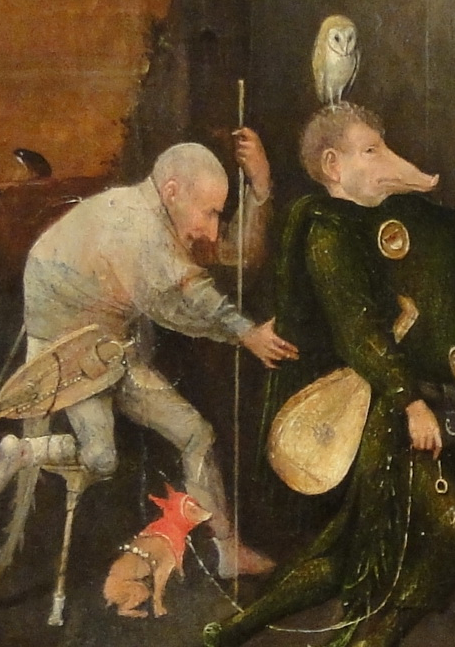As discussed in "GAEL," what I noticed first was the lion, green gorilla, and elephant, arranged in a line along the left side of the picture. Then I noticed that one of the elephants in the book is apparently named Eric, and that the cover shows an elephant right next to a knight on horseback -- encoding the name of Eric Knight, the author of the novel Lassie Come-Home. Just below Eric and the Knight is a golden jackal, suggesting the golden dog on the cover of Lassie Come Home. In my post "Lassie Come Home," I recorded a hunch that Lassie has something to do with the Woman of Revelation 12, who is menaced by the Dragon and has to go into hiding. Sure enough, right above Eric and the Knight on the cover is a menacing-looking dragon in flight. The D page in Animalia is titled "Diabolical Dragons Daintily Devouring Delicious Delicacies." Revelation 12 says that the Dragon is "called the Devil" (i.e, diabolical) and that it "stood before the woman which was ready to be delivered, for to devour her child as soon as it was born."
The Knight carries a banner, the end of which points to a herd of zebra -- a juxtaposition which suggests the zebra-striped flag of Brittany:
The flag of Normandy, the other part of Armorica, is a red field with two gold lions.
Under the banner is another black-and-white animal, an ostrich. In The Satanic Verses, the image of an out-of-place ostrich running along the English beach is associated with the Norman conquest. Rosa Diamond has just been daydreaming about that history -- "Come on, you Norman ships, she begged: let's have you, Willie-the-Conk" -- when
Running along the midnight beach in the direction of the Martello tower and the holiday camp, -- running along the water's edge so that the incoming tide washed away its footprints, -- swerving and feinting, running for its life, there came a full-grown, large-as-life ostrich.
These references to travel between Britain and Armorica fit right in with "The Gospel of Luke on Lobsterback," where I even propose that the "lobsters" may actually be soldiers, like our Knight. The Knight has the face of a hog, and both hogs and lobsters are well-known as non-kosher animals. As in Peter's vision in Acts, "unclean" animals may symbolize "Gentiles" -- the Gentiles entrusted with bringing the lost sheep of Israel, and their lost Gospel of Light, safely home:
I will lift up mine hand to the Gentiles, and set up my standard to the people; and they shall bring thy sons in their arms, and thy daughters shall be carried upon their shoulders (1 Ne. 21:22).
The language is from Isaiah, of course, and for "set up my standard" many translations have something like "raise high my banner."
Confirmation that this hog Knight with his banner has to do with the Lassie Come Home story can be found on the H page of Animalia, where we learn that the hogs on horseback are "hurrying homeward":
William Wright's recent post about Ali with an I and Daniel with an L led me to look up a 2019 post of mine about Dante's claim that I and EL were the two earliest names for God. I was surprised to find that the post also included this detail from a painting by Hieronymus Bosch:
My interest at the time was in the owl, and how it proves that the creature in the basket in Bosch's painting The Conjurer is also an owl (not a monkey, as some have claimed). Looking at it now, though, what I see is an anthropomorphic hog, like our Knight, leading a golden dog on a leash -- as if bringing Lassie home. He is also dressed in dark green and carries a lute, suggesting this detail from the L page of Animalia:
Hieronymus is the Latin form of the name Jerome. I don't know how I could have posted so much about lions in a library, even referring to the library as a "study," without making the connection with Albrecht Dürer's famous copper engraving Saint Jerome in His Study:
Sleeping on the floor next to the saint's pet lion is a contented-looking dog. Lassie has come home.
One more thing to mention. In the vision described in "Étude brute?" -- which primed me to notice the Lions in a Library image in Animalia -- an indirect vision of the Holy Family -- Joseph and his wife and son, radiating light to bright for me to look at them (perhaps identical to William Wright's "Family of Light"?) -- was followed by my being led into a library or study by a "Bull of Heaven," which I described as being "something like an aurochs." Later I noted that the Bull is a traditional symbol of the House of Joseph. This symbolism comes from Deuteronomy:
[Joseph's] glory is like the firstling of his bullock, and his horns are like the horns of unicorns: with them he shall push the people together to the ends of the earth: and they are the ten thousands of Ephraim, and they are the thousands of Manasseh (Deut. 33:17).
Where the King James has unicorns, the Douay-Rheims translation favored by Catholics has -- following no less an authority than Saint Jerome himself! -- rhinoceros. Most modern translations have wild ox, meaning the aurochs. These three animals, then, may be considered interchangeable as symbols of the House of Joseph. Here they are on the cover of Animalia:
The unicorn and rhinoceros caught my eye first, but there's also a yak in the background. Does that count as a "wild ox"? We usually think of the yak as a domestic animal, but there are still wild yaks in the Himalayas. The domestic yak is Bos grunniens ("grunting ox"), while the wild yak is Bos mutus ("silent ox"). Why bring up the scientific names? Because I specifically described the animals in my vision as "silent bulls."










